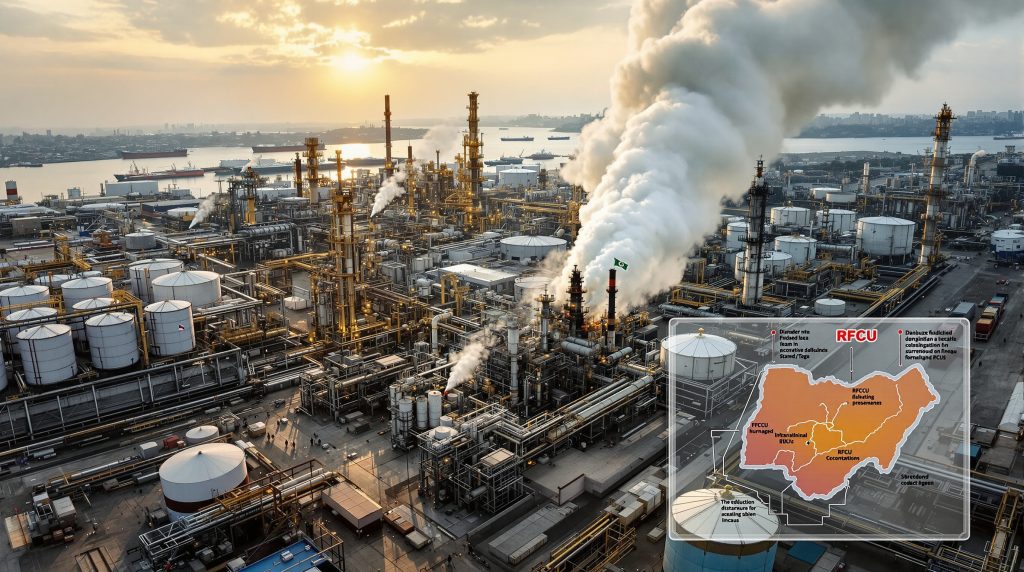What Caused the Dangote Refinery's Gasoline Production Shutdown?
The Dangote Refinery, Africa's largest petroleum processing facility, has encountered a significant technical setback with its gasoline production unit. The 204,000 barrel-per-day Residue Fluidized Catalytic Cracking Unit (RFCCU) was taken offline in late August 2025 due to catalyst leaks and associated technical complications. This critical component is responsible for converting heavy petroleum residues into valuable lighter products, particularly gasoline, making its operational status vital to the refinery's overall productivity.
Engineers discovered the catalyst leakage during routine monitoring, prompting an immediate shutdown to prevent potential equipment damage and safety hazards. The technical complexity of the RFCCU system requires specialized repair procedures that cannot be rushed without risking further complications.
Timeline of the Production Halt
| Date | Development |
|---|---|
| August 29, 2025 | Initial shutdown of the RFCCU after detection of catalyst leaks |
| Early September 2025 | Technical assessment completed, repairs initiated |
| Mid-September 2025 | Repair work continues with specialized equipment |
| Late October/Early November 2025 | Projected restart timeline (subject to successful repairs) |
How Long Will the Dangote Refinery Gasoline Production Remain Offline?
Initial repair estimates suggested a relatively short downtime of approximately two weeks. However, as technical teams further assessed the situation, the complexity of the required repairs became more apparent. Current projections indicate the gasoline production unit may remain offline until early November 2025, representing a significant extension beyond original estimates.
The extended timeline reflects several factors:
- The need for specialized replacement parts that require custom manufacturing
- Thorough testing protocols to ensure system integrity before restart
- Comprehensive catalyst replacement and regeneration procedures
- Implementation of additional safeguards to prevent recurrence
Industry experts familiar with similar RFCCU systems note that rushing repairs could lead to additional complications, potentially extending the downtime even further. The refinery management has prioritized a thorough repair approach over expedited but potentially incomplete solutions.
What Is the Dangote Refinery's Significance in Global Oil Markets?
Capacity and Strategic Importance
The Dangote Refinery represents a transformative development in Africa's petroleum landscape, with its massive 650,000 barrel-per-day processing capacity making it the continent's largest refinery by a substantial margin. Completed after years of construction and an investment exceeding $19 billion, the facility was designed to revolutionize Nigeria's position in global oil market influence.
Key statistics highlighting the refinery's significance include:
| Metric | Value |
|---|---|
| Total Refining Capacity | 650,000 barrels per day |
| Gasoline Production Capacity (RFCCU) | 204,000 barrels per day |
| Total Investment | $19+ billion |
| Land Area | 2,635 hectares |
| Storage Capacity | Over 4.6 billion liters |
The facility was designed to not only meet Nigeria's domestic petroleum product needs but also position the country as a net exporter of refined products, reversing its long-standing dependence on imported fuels despite being Africa's largest crude oil producer.
Market Positioning
Prior to this production halt, the Dangote Refinery had been steadily increasing its operational capacity throughout 2025, gradually reshaping regional and international fuel supply patterns. The facility had begun exporting gasoline to various markets, including:
- West African neighboring countries
- European markets
- North American destinations, including the United States
This export capability represented a significant shift in traditional petroleum product trade flows, with Africa becoming an exporter rather than primarily an importer of refined products.
How Is the Production Halt Affecting Global Gasoline Markets?
Immediate Market Impacts
The unexpected shutdown of such a significant gasoline production unit has created ripple effects across global petroleum markets:
-
Atlantic Basin Supply Tightening: The gasoline market in the Atlantic Basin has experienced noticeable tightening, with reduced availability from this major new supply source.
-
U.S. Gasoline Margins: Despite the end of the traditional summer driving season when gasoline demand typically declines, U.S. gasoline refining margins have strengthened following the Dangote outage announcement.
-
European Refinery Activity: European refiners have seen increased demand for their gasoline output to compensate for the supply gap.
-
Price Volatility: Regional gasoline price benchmarks have shown increased volatility as traders adjust positions in response to the supply disruption.
Quantifiable Market Effects
The market impacts can be observed in several key metrics:
- U.S. gasoline crack spreads (the difference between gasoline prices and crude oil) increased by approximately 8-10% in the days following the shutdown announcement
- Gasoline futures contracts for near-term delivery saw premium increases relative to longer-dated contracts
- Tanker freight rates for gasoline shipments from Europe to West Africa increased as alternative supply sources were sought
What Challenges Has the Dangote Refinery Faced Since Opening?
The current gasoline production halt is not the first operational challenge the massive refinery has encountered since beginning operations. The facility has experienced a series of technical and operational hurdles:
Previous Technical Setbacks
-
Earlier RFCCU Issues: Prior to the current shutdown, the refinery had already experienced reduced RFCCU output earlier in 2025 due to technical adjustments and optimization challenges.
-
Startup Delays: The initial commissioning of various processing units faced several delays as systems were gradually brought online and calibrated.
-
Crude Supply Coordination: Securing consistent and appropriate crude oil feedstock blends presented logistical challenges, particularly as the refinery was designed to process a wide variety of crude types.
-
Workforce Development: Building and training a skilled workforce capable of operating such a technologically advanced facility required substantial time and resources.
Management Perspectives
Refinery management has acknowledged the complexity of operating such a massive and technologically sophisticated facility, noting that operational challenges are not uncommon during the early phases of a major refinery's lifecycle. They have emphasized their commitment to:
- Implementing robust maintenance protocols
- Continuous staff training and development
- Gradual capacity increases rather than rushed ramp-ups
- Building redundancy into critical systems
Despite acknowledging previous frequent outages, management has disputed some external characterizations of operational issues, highlighting plans to further scale up production capacity by December 2025 once current challenges are resolved.
How Will This Shutdown Impact Nigeria's Fuel Import Dependence?
Nigeria has long faced the paradox of being Africa's largest crude oil producer while simultaneously depending heavily on imported refined petroleum products due to insufficient domestic refining capacity. The Dangote Refinery was positioned as a solution to this longstanding challenge.
Short-Term Import Requirements
The current production halt means Nigeria will need to continue relying on imported gasoline to meet domestic demand in the near term. This has several implications:
- Foreign Exchange Pressure: Continued need for foreign currency to purchase imported fuels, straining Nigeria's forex reserves
- Price Stability Challenges: Potential for fuel price volatility as supply chains adjust
- Logistical Adjustments: Need to maintain import infrastructure and supply relationships that were expected to be scaled down
Long-Term Outlook
Despite the current setback, the long-term trajectory remains positive for Nigeria's fuel self-sufficiency:
- Once fully operational, the Dangote Refinery alone has sufficient capacity to meet Nigeria's entire domestic fuel demand
- The experience gained from addressing current technical challenges will likely improve future operational reliability
- Additional planned refinery projects in Nigeria could further strengthen domestic production capacity
Industry analysts project that by mid-2026, assuming successful resolution of current technical issues, Nigeria could transition from a net importer to a net exporter of refined petroleum products.
What Does This Mean for Regional Energy Security?
West African Context
The Dangote Refinery represents a potential transformation in West Africa's energy security landscape. The region has historically been vulnerable to global supply disruptions and price volatility due to heavy dependence on imported fuels.
Key regional implications of the current production halt include:
-
Delayed Energy Independence: West African nations that had begun negotiations for product supply from Dangote must continue existing import arrangements.
-
Price Stability: The promise of more stable, regionally-produced fuel supplies with potentially lower transportation costs remains on hold.
-
Foreign Exchange Requirements: Countries must continue allocating foreign exchange reserves for fuel imports rather than redirecting these resources to other development priorities.
Comparative Regional Impact
| Country | Pre-Dangote Import Dependence | Potential Post-Dangote Impact | Current Status Due to Shutdown |
|---|---|---|---|
| Nigeria | 80% of refined products | Near self-sufficiency | Continued import dependence |
| Ghana | 100% import dependent | Potential regional supplier | Maintaining existing supply chains |
| Cameroon | 80% import dependent | Reduced import needs | No immediate change |
| Senegal | 100% import dependent | Diversified supply options | Continued reliance on traditional suppliers |
When Will Gasoline Production Resume at Dangote Refinery?
Repair Progress and Projections
According to technical assessments and industry sources, the repair timeline for the RFCCU involves several critical phases:
-
Diagnostic Completion: Thorough assessment of catalyst leakage points and associated damage (completed early September)
-
Parts Procurement: Acquisition of specialized replacement components, some requiring custom manufacturing (in progress)
-
System Repairs: Physical repair work on affected systems (currently underway)
-
Catalyst Replacement: Removal of damaged catalyst material and installation of fresh catalyst (scheduled for October)
-
System Testing: Comprehensive testing under controlled conditions before full restart (projected for late October)
Based on current progress, industry analysts project gasoline production could resume by early November 2025, though this timeline remains subject to successful completion of all repair phases without additional complications.
Factors That Could Affect the Timeline
Several variables could potentially accelerate or delay the restart:
Potential Accelerators:
- Availability of pre-fabricated replacement parts from global suppliers
- Deployment of additional specialized technical teams
- Simplified repair approach if damage is less extensive than initially assessed
Potential Delays:
- Discovery of additional damage during repair processes
- Supply chain disruptions affecting specialized component delivery
- Need for more extensive system testing before restart
What Are the Implications for Global Gasoline Trade Flows?
Shifting Supply Patterns
The Dangote Refinery's gasoline production halt has triggered notable adjustments in international gasoline trade flows:
-
European Exports: European refiners have increased gasoline shipments to West Africa to fill the supply gap.
-
U.S. Import Adjustments: U.S. markets that had begun receiving shipments from Dangote have reverted to traditional supply sources.
-
Middle Eastern Refiners: Some Middle Eastern refineries have redirected cargoes originally destined for Asian markets to capture opportunities in the Atlantic Basin.
-
Regional Storage Drawdowns: Commercial gasoline inventories in key trading hubs have seen increased drawdowns as traders respond to the supply disruption.
Quantifiable Trade Flow Shifts
| Region | Pre-Shutdown Flow | Post-Shutdown Adjustment |
|---|---|---|
| Europe to West Africa | Declining volumes | 15-20% increase in shipments |
| U.S. Gulf Coast to East Coast | Stable volumes | Increased coastal shipments |
| Middle East to Africa | Limited volumes | Opportunistic cargo redirections |
| Dangote to Export Markets | Growing volumes | Complete cessation |
How Does This Compare to Other Major Refinery Outages?
Historical Context
Major refinery outages are not uncommon in global petroleum markets, though their impacts vary based on timing, market conditions, and the specific units affected. The Dangote situation can be compared to several notable historical refinery disruptions:
-
U.S. Gulf Coast Hurricane Impacts (2021): Multiple refineries with combined capacity exceeding 2 million barrels per day were temporarily offline, causing significant but relatively short-term market disruptions.
-
European Refinery Strikes (2023): Coordinated labor actions across multiple European refineries removed approximately 1.2 million barrels per day of capacity for several weeks, creating pronounced regional supply tightness.
-
Saudi Aramco Abqaiq Facility Attack (2019): Damage to the world's largest oil processing facility temporarily removed 5.7 million barrels per day of capacity, triggering global price spikes.
Comparative Analysis
| Aspect | Dangote Outage | Typical Major Refinery Outage |
|---|---|---|
| Duration | Potentially 8-10 weeks | 2-4 weeks for planned maintenance; 4-8 weeks for unplanned disruptions |
| Market Impact | Moderate regional effect | Varies widely based on refinery significance |
| Advance Notice | Unplanned/sudden | Often planned and telegraphed to markets |
| Capacity Affected | 204,000 bpd (gasoline specific) | Varies widely |
The Dangote situation is notable for its extended duration and the fact that it affects a relatively new facility that markets were still incorporating into supply projections.
FAQ: Key Questions About the Dangote Refinery Shutdown
Is this shutdown related to design flaws or operational inexperience?
Industry experts suggest the current technical issues are not necessarily indicative of fundamental design flaws. New refineries typically experience a series of operational adjustments during their first years of operation. The complexity of the RFCCU system makes it particularly sensitive to optimization challenges, and catalyst leakage issues have occurred at other well-established refineries globally.
Could this shutdown affect Dangote's long-term viability?
While the current production halt represents a significant short-term setback, it is unlikely to fundamentally alter the refinery's long-term economic viability. The facility's strategic location, massive scale, and integration advantages remain intact. The financial impact, while substantial, represents a relatively small percentage of the overall project investment.
Will this delay other planned production increases at the refinery?
Management has indicated that despite the current RFCCU issues, their timeline for reaching full operational capacity by December 2025 remains in place. Other processing units continue to operate, and the experience gained from addressing the current technical challenges may actually improve future operational stability.
How is this affecting Nigeria's fuel subsidy reform efforts?
Nigeria's government has been gradually reforming its fuel subsidy system, with domestic production from Dangote expected to help stabilize prices. The current production halt temporarily complicates this transition by maintaining import dependence, though the long-term trajectory of subsidy reform remains unchanged.
Conclusion: Market Outlook and Future Prospects
The Dangote Refinery's gasoline production halt represents a significant but temporary setback for what remains a transformative project for African energy markets. While the extended shutdown period has created short-term market disruptions and delayed the facility's full impact on regional supply patterns, the fundamental value proposition remains intact.
Once repairs are completed and the RFCCU returns to operation, the refinery is positioned to gradually resume its role in reshaping petroleum product flows across the Atlantic Basin. The technical knowledge gained through addressing the current challenges may ultimately strengthen the facility's long-term operational reliability.
Market participants should anticipate continued adjustments in gasoline trade flows through early November, with gradual normalization as production resumes. The experience demonstrates both the significance of the Dangote Refinery to emerging oil market trends and the inherent complexities in operating such massive, technologically advanced facilities.
Recent oil price crash analysis suggests that such refinery outages, when combined with existing market pressures, can create significant volatility. Moreover, according to experts monitoring declining oil production effects in major producing regions, these temporary disruptions take on greater significance when baseline production is already constrained.
The situation remains closely tied to the OPEC production outlook, as any adjustments in crude oil supply from major producing nations could further complicate the global petroleum product balance during this period of reduced refining capacity.
Further Exploration:
Readers interested in learning more about global refinery operations and technical challenges facing Africa's largest refinery can also explore related educational content at OilPrice.com, which offers regular updates on petroleum industry developments worldwide.
Looking for Major Trading Opportunities in the Resources Sector?
Stay ahead of the market with Discovery Alert's proprietary Discovery IQ model, which provides real-time notifications of significant ASX mineral discoveries and actionable trading insights. Visit the Discovery Alert discoveries page to see how major mineral finds have historically generated substantial returns for early investors.




